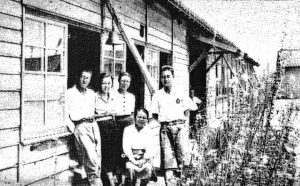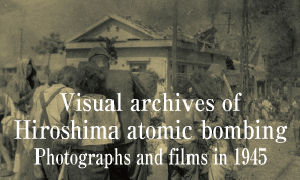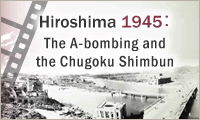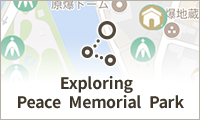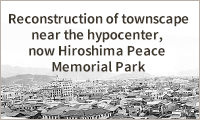Documenting Hiroshima of 1946: April, New school building for Hakushima National School
Apr. 17, 2025
by Maho Yamamoto, Staff Writer
In April 1946, Hakushima National School (now Hakushima Elementary School in Naka Ward) in Hiroshima resumed classes in a new but austere school building. While many schools that lost their buildings in the atomic bombing were forced to hold classes in ruins or in other facilities, this school was the first in the city to resume classes in a new building, according to a publication to commemorate the 100th anniversary of the school’s founding.
Yasu Tsuchida, a teacher who played a central role in the reconstruction, provided ephemera about the school building to Hakushima Elementary school in 1995. According to the materials, the new school building was completed in February, 1946, on the site of the school’s old building. The single-story structure had five classrooms on the east side, six classrooms on the north side, a small auditorium, and a night duty room, covering approximately 830 square meters. Its completion was celebrated in a ceremony on April 18. “When we welcomed the children who had been temporarily studying at other schools into our new building, we all held each other’s hands and cried,” Mr. Tsuchida wrote in his personal account Genbaku Ki (Record of the atomic bomb) published in 1965. Mr. Tsuchida passed away at the age of 81 in 1997.
The school was located about 1.5 kilometers from the hypocenter, and its school building was completely destroyed by fire. About 100 children who were at the school are believed to have died instantly. Classes resumed in September, but the school had to borrow space at Ushita National School (now Ushita Elementary School in Higashi Ward).
Mr. Tsuchida himself suffered severe injuries to his chest and was recuperating when he heard the school might be closed. He decided to work for its reconstruction, believing the children who escaped the danger through the evacuation program would eventually return. The city was opposed to rebuilding the school, but Mr. Tsuchida negotiated with the city government while obtaining scrap materials for free from the nearby former military barracks for the army corps of engineers and used them for beams and columns. Once the outer structure of the school was completed, the city prepared a budget and cooperated in securing reconstruction materials. Children collected roof tiles.
Shortly after they celebrated the completion of the new school building, Mr. Tsuchida began suffering from persistent diarrhea and high fever in June, and his white blood cell count dropped. He parted from the students and returned to his hometown of Zushi, Kanagawa Prefecture, to focus on his treatment and recovery.
Sumie Ikeda, 81, a resident of Higashi Ward, was a teacher at the school. She made a supplementary reader on the school’s reconstruction. “Mr. Tsuchida believed that rebuilding the school would revitalize the community. I feel his strong spirit,” said Ms. Ikeda. In 1949, a two-story wooden school building was completed at its current location. Mr. Tsuchida served as chairman of the group of A-bomb survivors living in Kanagawa Prefecture, which was established in 1955, and participated in petitioning the Diet to give support to atomic bomb survivors.
(Originally published on April 17, 2025)
In April 1946, Hakushima National School (now Hakushima Elementary School in Naka Ward) in Hiroshima resumed classes in a new but austere school building. While many schools that lost their buildings in the atomic bombing were forced to hold classes in ruins or in other facilities, this school was the first in the city to resume classes in a new building, according to a publication to commemorate the 100th anniversary of the school’s founding.
Yasu Tsuchida, a teacher who played a central role in the reconstruction, provided ephemera about the school building to Hakushima Elementary school in 1995. According to the materials, the new school building was completed in February, 1946, on the site of the school’s old building. The single-story structure had five classrooms on the east side, six classrooms on the north side, a small auditorium, and a night duty room, covering approximately 830 square meters. Its completion was celebrated in a ceremony on April 18. “When we welcomed the children who had been temporarily studying at other schools into our new building, we all held each other’s hands and cried,” Mr. Tsuchida wrote in his personal account Genbaku Ki (Record of the atomic bomb) published in 1965. Mr. Tsuchida passed away at the age of 81 in 1997.
The school was located about 1.5 kilometers from the hypocenter, and its school building was completely destroyed by fire. About 100 children who were at the school are believed to have died instantly. Classes resumed in September, but the school had to borrow space at Ushita National School (now Ushita Elementary School in Higashi Ward).
Mr. Tsuchida himself suffered severe injuries to his chest and was recuperating when he heard the school might be closed. He decided to work for its reconstruction, believing the children who escaped the danger through the evacuation program would eventually return. The city was opposed to rebuilding the school, but Mr. Tsuchida negotiated with the city government while obtaining scrap materials for free from the nearby former military barracks for the army corps of engineers and used them for beams and columns. Once the outer structure of the school was completed, the city prepared a budget and cooperated in securing reconstruction materials. Children collected roof tiles.
Shortly after they celebrated the completion of the new school building, Mr. Tsuchida began suffering from persistent diarrhea and high fever in June, and his white blood cell count dropped. He parted from the students and returned to his hometown of Zushi, Kanagawa Prefecture, to focus on his treatment and recovery.
Sumie Ikeda, 81, a resident of Higashi Ward, was a teacher at the school. She made a supplementary reader on the school’s reconstruction. “Mr. Tsuchida believed that rebuilding the school would revitalize the community. I feel his strong spirit,” said Ms. Ikeda. In 1949, a two-story wooden school building was completed at its current location. Mr. Tsuchida served as chairman of the group of A-bomb survivors living in Kanagawa Prefecture, which was established in 1955, and participated in petitioning the Diet to give support to atomic bomb survivors.
(Originally published on April 17, 2025)

